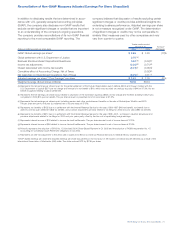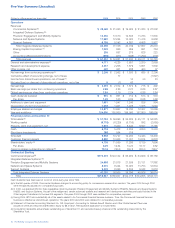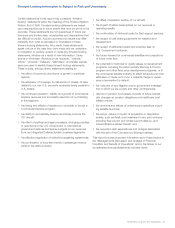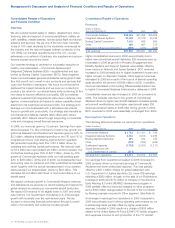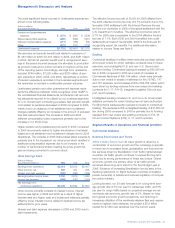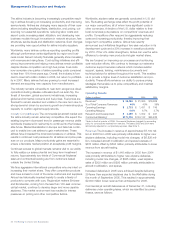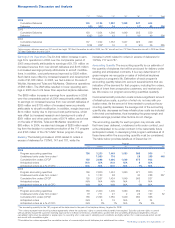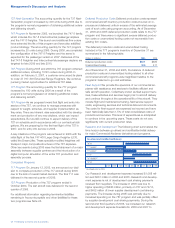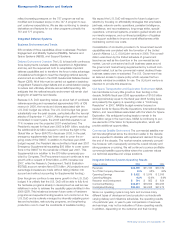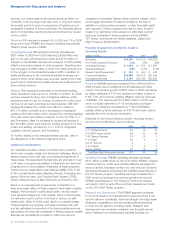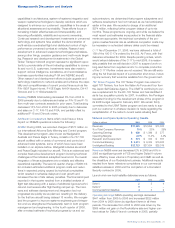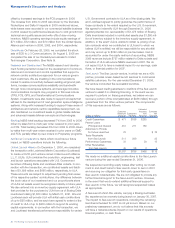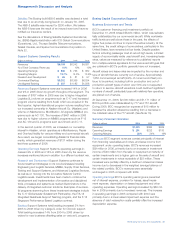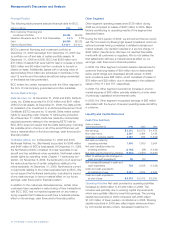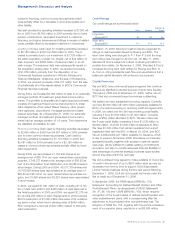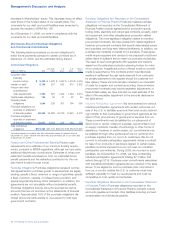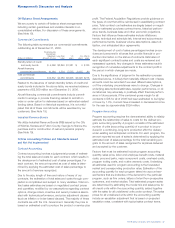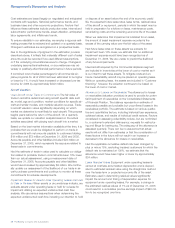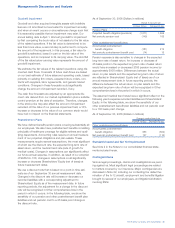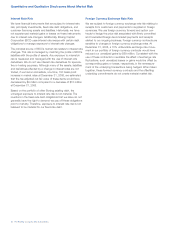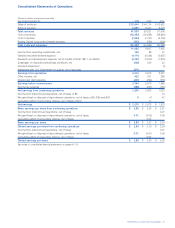Boeing 2006 Annual Report Download - page 33
Download and view the complete annual report
Please find page 33 of the 2006 Boeing annual report below. You can navigate through the pages in the report by either clicking on the pages listed below, or by using the keyword search tool below to find specific information within the annual report.
capabilities in architectures, system-of-systems integration and
weapon systems technologies to develop solutions which are
designed to enhance our customers’ capabilities in the areas of
situational awareness and survivability. These efforts focus on
increasing mission effectiveness and interoperability, and
improving affordability, reliability and economic ownership.
Continued research and development investments in unmanned
technology and systems have enabled the demonstration of
multi-vehicle coordinated flight and distributed control of high-
performance unmanned combat air vehicles. Research and
development in advanced weapons technologies emphasizes,
among other things, precision guidance and multi-mode target-
ing. Research and development investments in the Global
Tanker Transport Aircraft program represent a significant oppor-
tunity to provide state-of-the-art refueling capabilities to domes-
tic and non-U.S. customers. Investments were also made to
support various intelligence, surveillance, and reconnaissance
business opportunities including P-8A and AEW&C aircraft.
Other research and development efforts include upgrade and
technology insertions to network-enable and enhance the capa-
bility and competitiveness of current product lines such as the
F/A-18E/F Super Hornet, F-15E Eagle, AH-64 Apache, CH-47
Chinook and C-17 Globemaster III.
Backlog PE&MS total backlog decreased 8% from 2005 to
2006 primarily due to deliveries and sales on F/A-18 and F-15
from multi-year contracts awarded in prior years. Total backlog
decreased 13% from 2004 to 2005 primarily due to deliveries
and sales on C-17, F/A-18 and P-8A, and partially offset by
additional F-15 and Chinook orders.
Additional Considerations Items which could have a future
impact on PE&MS operations include the following:
AEW&C During 2006, we recorded charges of $770 million on
our international Airborne Early Warning and Control program.
This development program, also known as Wedgetail in
Australia and Peace Eagle in Turkey, consists of a 737-700
aircraft outfitted with a variety of command and control and
advanced radar systems, some of which have never been
installed on an airplane before. Wedgetail includes six aircraft
and Peace Eagle includes four aircraft. This is an advanced and
complex fixed-price development program involving technical
challenges at the individual subsystem level and in the overall
integration of these subsystems into a reliable and effective
operational capability. The second-quarter charge of $496 mil-
lion included estimated additional program costs and reduc-
tions in expected pricing caused by technical complexities
which resulted in schedule delays and cost growth and
increased the risk of late delivery penalties. The financial impact
recorded in that quarter resulted from a detailed analysis of
flight test data along with a series of additional rigorous techni-
cal and cost reviews after flight testing ramped up. The hard-
ware and software development and integration had not
progressed as quickly as we planned, resulting in the delivery
for the first two aircraft being delayed 15 months. We reorgan-
ized the program to improve systems engineering and integra-
tion and we strengthened the leadership team in both program
management and engineering. In the fourth quarter of 2006,
after a revised estimate of technical progress by us and our
subcontractors, we determined that program subsystems and
software development had not matured as we had anticipated
earlier in the year. We recorded a charge of an additional
$274 million, reflecting further program delays of up to six
months. These programs are ongoing, and while we believe the
most recent cost estimates incorporated in the financial state-
ments are appropriate, the technical complexity of the pro-
grams creates financial risk as additional completion costs may
be necessary or scheduled delivery dates could be missed.
C-17 As of December 31, 2006, we have delivered a total of
159 of the 190 C-17s ordered by the U.S. Air Force, with final
deliveries scheduled for 2009. Despite pending orders, which
would extend deliveries of the C-17 to mid-2009, it is reason-
ably possible that we will decide in 2007 to suspend work on
long-lead items from suppliers and/or to complete production
of the C-17 if further orders are not received. We are still evalu-
ating the full financial impact of a production shut-down, includ-
ing any recovery that would be available from the government.
767 Tanker Program The 767 Tanker Program has orders for
eight 767 Tankers, four from the Italian Air Force and four from
the Japan Self Defense Agency. The USAF is continuing to pur-
sue a replacement for the KC-135 Tanker and has identified it
as its top acquisition priority for 2007. In addition, the Pentagon
requested funding for the development phase of the program in
its 2008 budget request in February 2007. We remain firmly
committed to the USAF Tanker program and are ready to sup-
port our customer in whatever decision is made regarding the
recapitalization of the nation’s current aerial refueling fleet.
Network and Space Systems Operating Results
(Dollars in millions) 2006 2005 2004
Revenues $11,980 $12,254 $13,023
% of Total Company Revenues 19%23%25%
Operating Earnings $÷÷«958 $÷1,399 $÷÷«577
Operating Margins 8.0%11.4%4.4%
Research and Development $÷÷«301 $÷÷«334 $÷«÷357
Contractual Backlog $÷8,001 $÷6,324 $10,923
Unobligated Backlog $23,723 $27,634 $25,019
Revenues N&SS revenues decreased 2% in 2006 and 6% in
2005 as significant growth in FCS and higher Delta IV volume
were offset by lower volume in Proprietary and GMD as well as
the divestiture of our Rocketdyne business. Additional impacts
resulted from fewer milestone completions in our commercial
satellite business in 2006 and the completion of a Homeland
Security contract in 2005.
Launch and new-build satellite deliveries were as follows:
2006 2005 2004
Delta II 224
Delta IV 3––
Commercial/Civil Satellites 432
Operating Earnings N&SS operating earnings decreased
$441 million from 2005 to 2006 and increased $822 million
from 2004 to 2005 driven by significant items in all three
periods. The decrease from 2005 to 2006 was driven by the
$569 million net gain on the Rocketdyne sale and higher con-
tract values for Delta IV launch contracts in 2005, partially
The Boeing Company and Subsidiaries 31
Management’s Discussion and Analysis


